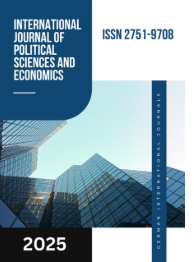SORPTION OF RHENIUM: RESEARCH, METHODS, AND SCIENTIFIC APPROACHES
DOI:
https://doi.org/10.55640/Keywords:
rhenium sorption, perrhenate ions, sorption methods, activated carbon, ion-exchange sorbents, zeolites, biomass, environmental purification, bioaccumulation, nanomaterialsAbstract
This article discusses the process of rhenium (Re) sorption and its effective methods. Since perrhenate ions (ReO₄⁻) are found in industrial waste and the environment, posing ecological risks, their efficient removal is one of the critical challenges. The paper analyzes various types of sorbents, including activated carbon, ion-exchange sorbents, zeolites, and biomass-based materials. The main mechanisms of the sorption process are described, including electrostatic forces, ion exchange, and Van der Waals interactions. In addition, technologies for rhenium recovery using modern nanomaterials and modified polymers are discussed. This review serves as an important information source for research aimed at reducing rhenium’s ecological hazards and developing efficient purification methods.
References
1.Азизова Х. М., Бабаев Т. М., & Каттаев Н. Т. (2023). SYNTHESIS OF CROSS-LINKED COPOLYMER OF ACRYLONITRILE WITH HEXAHYDRO-1,3,5-TRIACRYLYL TRIAZINE BY SUSPENSION COPOLYMERIZATION. Intent Research Scientific Journal, 2(5), 6–11. Retrieved from https://intentresearch.org/index.php/irsj/article/view/91
2.Benoit, J., & Schubert, T. (2015). Perrhenate removal from aqueous solutions using zeolites: An effective sorption approach. Environmental Science & Technology, 49(22), 13556–13564.
3.Kim, H., & Lee, S. (2019). Perrhenate adsorption on ion-exchange resins: A comparative study of selectivity and efficiency. Journal of Hazardous Materials, 380, 120848.
4.Li, Z., & Liu, Q. (2020). Adsorption of perrhenate from aqueous solutions using modified carbon-based adsorbents. Chemical Engineering Journal, 382, 122974.
5.Patil, N., & Jadhav, S. (2021). Effect of temperature and pH on perrhenate adsorption by modified biosorbents. Journal of Environmental Sciences, 95, 15–22.
6.Sasaki, K., & Tanaka, N. (2018). Sorption of rhenium and perrhenate onto ion-exchange resins: A kinetic study. Separation Science and Technology, 53(16), 2633–2643.
7.Huang, S., & Xie, W. (2022). Recent advances in the use of sorbents for rhenium and perrhenate removal from aqueous solutions. Environmental Pollution, 282, 117015.
8.Chung, J., & Lee, M. (2016). Removal of rhenium from aqueous solutions by adsorptive materials: A review. Journal of Environmental Management, 182, 340–350.
9.Mirkhamitova Dilorom Khudaiberdievna, Azizova Kholida Mumin qizi, & Jadilova Dilnavoz Abulazizovna. (2023). Granular copolymer synthesis of acrylonitrile and hexahydro 1.3.5-triacryliltriazine and its physicochemical properties. American Journal of Engineering , Mechanics and Architecture (2993-2637), 1(8), 44–47. Retrieved from https://grnjournal.us/index.php/AJEMA/article/view/968
10.N. Kattaev, B. Tuygun, D. Adinaeva, M. Jumaev, K. Azizova, A new granulated sorbent based on acrylonitrile: Synthesis and physico-chemical properties, BIO Web Conferences, 95, 01043 (2024)
Downloads
Published
Issue
Section
License

This work is licensed under a Creative Commons Attribution 4.0 International License.
Authors retain the copyright of their manuscripts, and all Open Access articles are disseminated under the terms of the Creative Commons Attribution License 4.0 (CC-BY), which licenses unrestricted use, distribution, and reproduction in any medium, provided that the original work is appropriately cited. The use of general descriptive names, trade names, trademarks, and so forth in this publication, even if not specifically identified, does not imply that these names are not protected by the relevant laws and regulations.







